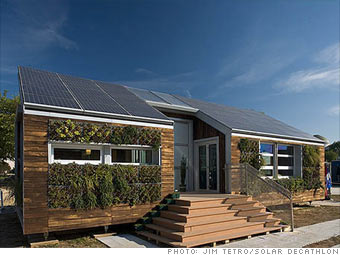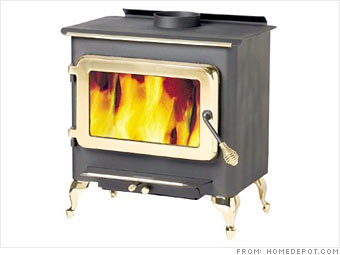6 Home heating alternatives
Staying warm this winter could get expensive. While there's not much homeowners can do about energy prices, there are some ways to reduce your dependence on traditional fuels.

Heating oil prices are expected to increase an average of 31% nationwide this winter, according to the Department of Energy. That compares to a nearly 22% average increase in natural gas prices, which makes the fuel a relative bargain.
More than half of America's households already use natural gas for heating purposes. But the nation's 8 million consumers of heating oil, most of which live in the Northeast, could benefit by switching to natural gas.
Homeowners can expect to pay between $3,000 and $7,000 to convert from heating oil to natural gas, said David Graves of National Grid, a natural gas and electricity company. The cost varies according to the size of the home, the efficiency of the system and installation fees.
But converting to natural gas may not be an option for everyone.
Unlike heating oil, natural gas is provided by a local utility and is not considered a "deliverable" fuel. That means homeowners who aren't within range of a utility's network may be stuck with heating oil.
Still, converting to natural gas has its advantages for those with access to it. In addition to heating, it can be used to cook, run a clothes dryer, fuel a fireplace and heat water.
What's more, natural gas burns cleaner than heating oil, Graves said. That minimizes wear and tear on the boiler and lowers maintenance costs. It also makes natural gas more environmentally friendly.
However, natural gas prices have risen steadily over the last few years and could easily go even higher in the future.
"I wouldn't be counting on price decreases in the long term," notes Martin Kushler of the American Council for an Energy-Efficient Economy. "It's unlikely that we'll see a return to low market prices of the 90's."

The pumps, also called ground-source heat pumps, use a network of tubes to circulate fluid underground to retrieve warmth in the winter and disperse heat in the summer.
A geothermal system costs between $5,000 and $10,000 to install, according to Jim Bose, executive director of the International Ground Source Heat Pump Association. That's substantially more than a conventional heating system.
While the upfront cost is significant, it can be recovered in energy savings after as little as five years, according to the Department of Energy. After that, the pumps can provide 25 years of heating and cooling service with relatively low maintenance costs.
Indeed, a geothermal system has the potential to reduce energy bills by as much as 35%, Bose said. And those savings are attracting the attention of many homeowners faced with the possibility of a 20% increase in heating bills this winter.
The federal government's $300 tax credit for qualified geothermal heat pumps expired last year. Lawmakers have yet to decide whether or not renew or expand the tax credit.

Passive solar heating -- designing a home to maximize its ability to collect and retain heat from the sun -- can greatly reduce home heating bills.
Of course, the effectiveness of passive solar heating depends heavily on the local climate, and it is not capable of replacing a conventional heating system altogether.
In most cases, passive solar heating is something to consider when designing a new home and may not be the best option for homeowners looking to save on heating bills in the short term.
Still, the long-term economic and environmental benefits of solar energy are significant.
Site orientation, the positioning of a house to maximize its exposure to sunlight, is the most basic component of passive solar heating.
Large, south-facing windows, plus floor and wall materials specially made to absorb and hold heat, are the other fundamental parts of passive solar design.
During the day, the windows allow sunlight to warm the floors and walls which naturally release that heat when the temperature begins to fall.

These systems use liquid or air to absorb solar radiation in a device called a collector. The stored heat can then be distributed through a building's existing heat system.
The cost of an active solar heating system is determined by the size of the house, the existing heating system and local climate. But a system using 4-6 collectors to provide heat for a 2,000 square foot house can cost between $15,000 and $20,000, according to Apricus Solar, a global solar thermal systems company.
In terms of efficiency, the right active solar heating system can provide 40% to 80% of a home's heating needs, according to the Department of Energy.
During the winter, however, active solar heating systems are not capable of entirely replacing a conventional heating system.
But active solar heating systems can also cut down on other utility costs by heating water during the summer.

One gallon of heating oil has a heat content of about 138,690 British thermal units, according to the DOE. The price for a gallon of heating oil is expected to jump to $4.34 nationwide this winter, which would give it a price per million Btu of $31.29.
A cord of wood, by contrast, costs roughly $200 and has an approximate heat content of 22 million Btu. That gives it a price per million Btu of only $9.
Homeowners can expect to pay at least $750 for a wood burning appliance and installation fees start at $250, according to consumerreports.org.
In contrast to old fashioned masonry fireplaces, which often suck heat out of a room, modern woodstoves generate more heat by burning gases and particulates before they can fly up the chimney.
Certain models are designed to fit inside an existing fireplace, which reduces installation costs.
But wood burning stoves are not for everyone. The cost of transporting firewood, given high gas prices, can make it more expensive for urban dwellers, notes Martin Kushler of the American Council for an Energy-Efficient Economy.
Despite improved efficiency, wood burning stoves still contribute to air pollution. And while wood is a renewable resource it is not as sustainable as solar or geothermal heat.

They burn pellets of compacted sawdust, wood chips, nutshells, corn kernels and other biomass waste. These fuels are generally easier to handle and have higher combustion efficiencies than wood.
The Environmental Protection Agency considers pellet burners among the "cleanest-burning heating appliances available today" and exempts them from smoke-emission testing requirements.
They typically cost between $1,700 and $3,000 and are often cheaper to install than wood burning stoves since many are "direct-vented" and do not require a chimney.
Pellet fuel is usually sold in 40 pound bags and a household that relies exclusively on a pellet stove for heat normally goes through two to three tons a year. On average, pellet fuel costs between $120 and $200 a ton, according to the DOE.
But pellet burning appliances, unlike wood burning stoves, have fans and controls that consume electricity.
No comments:
Post a Comment